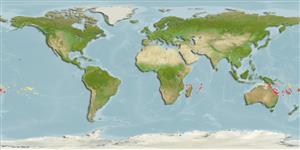>
Ovalentaria/misc (Various families in series Ovalentaria) >
Pomacentridae (Damselfishes) > Pomacentrinae
Etymology: Amphiprion: Greek, amphi = on both sides + Greek, prion, -onos = saw (Ref. 45335).
Environment: milieu / climate zone / depth range / distribution range
Ekologi
marina revassocierade; ej vandrande; djupintervall 1 - 25 m (Ref. 7247). Subtropical; 10°S - 32°S
Western Pacific: eastern Australia (Great Barrier Reef and Coral Sea, northern New South Wales), New Caledonia, and Loyalty Islands. Recently reported from Tonga (Ref. 53797).
Size / Vikt / Age
Maturity: Lm ? range ? - ? cm
Max length : 9.0 cm SL hane/ej könsbestämd; (Ref. 7247)
Taggstrålar i ryggfenan (totalt): 10 - 11; Mjukstrålar i ryggfenan (totalt): 14-17; Taggstrålar i analfenan 2; Mjukstrålar i analfenan: 13 - 14. Body and head orange with two black-edged white bars; the first running from the top of the head across the face, just behind the eye; the second from the mid portion of the dorsal fin. Caudal peduncle and caudal fin white.
Life cycle and mating behavior
Könsmognad | Reproduktion | Lek | Ägg | Fecundity | Larver
Oviparous, distinct pairing during breeding (Ref. 205). Eggs are demersal and adhere to the substrate (Ref. 205). Males guard and aerate the eggs (Ref. 205). Also Ref. 7471.
Allen, G.R., 1991. Damselfishes of the world. Mergus Publishers, Melle, Germany. 271 p. (Ref. 7247)
IUCN Red List Status (Ref. 130435)
Threat to humans
Harmless
Human uses
Akvarium: Kommersiell
Ytterligare information
referenserVattenbrukVattenbruksprofilAvelslinjerGenetikElectrophoresesÄrftlighetSjukdomarBehandlingNutrientsMass conversion
Verktyg
Special reports
Download XML
Internet-källor
Estimates based on models
Preferred temperature (Ref.
123201): 24.6 - 27.9, mean 26.4 °C (based on 559 cells).
Phylogenetic diversity index (Ref.
82804): PD
50 = 0.5000 [Uniqueness, from 0.5 = low to 2.0 = high].
Bayesian length-weight: a=0.02455 (0.01556 - 0.03872), b=2.96 (2.83 - 3.09), in cm total length, based on LWR estimates for this species & (Sub)family-body (Ref.
93245).
Trofisk nivå (Ref.
69278): 2.7 ±0.29 se; based on food items.
Resiliens (Ref.
120179): Hög, lägsta populationsfördubblingstid mindre än 15 månader (Preliminary K or Fecundity.).
Fishing Vulnerability (Ref.
59153): Low vulnerability (10 of 100).
Nutrients (Ref.
124155): Calcium = 81.6 [33.8, 152.1] mg/100g; Iron = 0.775 [0.439, 1.462] mg/100g; Protein = 18.8 [17.6, 20.1] %; Omega3 = 0.177 [0.093, 0.330] g/100g; Selenium = 10.6 [4.7, 22.7] μg/100g; VitaminA = 62.5 [14.7, 244.4] μg/100g; Zinc = 1.28 [0.77, 2.03] mg/100g (wet weight);
